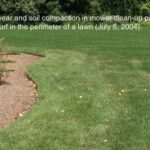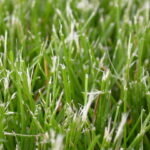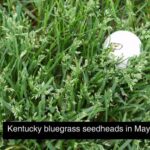Category: Maintaining a Home Lawn
September is a Crucial Time to Fertilize All Cool-Season Turfs
Early to mid-September is the most important time to fertilize cool-season turfgrasses like creeping bentgrass, Kentucky bluegrass, perennial ryegrass, and tall or fine fescue. September fertilization is crucial on all turf areas regardless if it is a lawn, athletic field, or golf course green, tee or fairway. Fertilization in mid-September encourages the production of new […]
Rust in Turf
The rain and temperatures this year have favored excellent turfgrass growth, and the N applied this spring is being depleted, thus favoring rust in even regularly fertilized turf areas. Rust symptoms are reddish-orange lesions or spots on the leaf blades and a rust-colored powder that you can rub off with your fingers. Rust will rarely […]
Thinning Turf Around Lawn Perimeter from zero-turning radius mowers
The popularity of the new zero-turning radius mowers is well-justified in terms of time and energy saving devices. However, these mowers are much heavier and faster than walk-behind mowers and thus increase compaction and turf wear. This is especially important around the perimeter of lawns (commonly referred to as the clean-up passes) where the mower […]
Finicky Poa annua Yellowing and Thinning on Greens
In spite of the cool and dry weather, Poa annua continues to yellow and sometimes thin on golf greens. Last week Poa annua was thinning and dieing in low areas from too much water, heat, and humidity (photo). However, the cool dry weather over the weekend allowed for maximum water loss through evapotranspiration. Plus since many irrigation systems were […]
Summer stress of Poa annua and Poa trivialis in Lawns and Sports Fields
Poa annua (annual bluegrass) and Poa trivialis (rough bluegrass) in athletic fields and lawns are starting to show signs of stress. The signs of stress include laying over (poor mow-ability), yellowing, and thinning. Patches of these fine-bladed grasses seemingly die overnight with even a minimum of drought stress. Though these grasses may have blended in with the desired turf […]
June Checklist
With the constant rains in May and now June, many turf management practices have been delayed and many practices have to be modified as a result of the rain: Fertilization: With all extended growth period using up much of the soil N plus the potential of minor N loss through leaching from all the rain, a […]
Time to consider a change…?
We are finally getting near the end of the spring growth flush for our major cool-season lawngrass species like Kentucky bluegrass, ryegrass and tall fescue. With a little help from mother-nature, hopefully mowing will be more manageable from here on out. During the past few weeks you may have noticed a decline in overall appearance […]
Early Dollar Spot on Golf Courses This Year
If you’re lucky enough to be in the areas of Indiana that have received ample rainfall, you are unfortunately starting to see dollar spot. The excess rain in parts of the state triggered rapid plant growth and infrequent mowing, which in turn forced clipping removal and removal of N from the system. The N in […]
Localized Dry Spot Returns for 2004
For those of you managing sand-based putting greens you may have noticed some turf areas that don’t seem to be vigorously growing even with the recent heavy rainfalls or regular irrigation (photo). Looking back, April and the early part of May was a challenging time for turf managers trying to manage water on the golf […]
Bumper Crop of Seedheads This Year
Cool-season turfgrasses such as Kentucky bluegrass and perennial ryegrass are now producing seedheads. This natural phenomenon is induced by daylength, but the intensity of seedhead production is affected primarily by temperature and is likely the cause of the above average seedhead production this year. Seedheads detract from the appearance of a lawn because they grow […]
May Fertilizer
As turfgrass growth is beginning to slow, it’s time to consider fertilizing your lawn. Applying fertilizer now should not increase vertical growth dramatically as long as moderate rates of nitrogen are used and will help your lawn retain it’s color and health. Apply 0.75 to 1.0 lbs. N/1000 sq. ft. with a product that contains […]
Sulfur is not Effective for Lowering pH of Turfed Soils
Soil testing is important in turf to help determine the soil pH and fertilization needs, especially for potassium and phosphorus. Acceptable soil pH for turf is between 6.0 and 7.5. Some distributors and soil testing labs will recommend applying sulfur to reduce the soil pH of turf when it is over 7.5. Unfortunately, you can […]
Prevention of Dog Urine Spots
We have received a ton of questions on dog urine spots this year, probably because it has been a very dry April. Dog urine will burn leaf blades because the high concentration of salts in the urine will pull water out of the leaf dehydrating the leaf. This problem is exaggerated by warm and/or dry […]
Bumpy Lawn?
Lawn seem bumpier this spring when you first mowed it? Bumpy, difficult-to-mow lawns can be caused by either above-ground factors or below-ground soil factors. If the bumpiness is due to patches of incompatible species of coarse, bunch grasses like tall fescue or orchardgrass growing in a stand of predominantly Kentucky bluegrass or perennial ryegrass, apply […]
Calculating the pounds of fertilizer to apply
There are literally thousands of fertilizers and fertilizer/pesticide combinations available to homeowners and professionals. Therefore, we can’t recommend how many pounds of fertilizer to apply, but rather we must recommend fertilization rates in pounds of nitrogen per thousand square feet or lbs N/1000ft 2 . Calculating the amount of fertilizer to purchase and apply is […]
Why we don’t recommend specific fertilizer/herbicide combinations for homeowners
We’ve received a number of emails asking for specific product recommendations for XYZ town in IN or IL, or even as far away as NY. Its very difficult, OK impossible, for us to recommend specific fertilizer/herbicide combinations because there is a large number of brands and an even larger number of fertilizer/herbicide combinations available on […]
Spring N: Do-It-Yourselfers vs Professional Recommendations
We recommend waiting until mid-May to fertilize for the vast majority of do-it-yourselfers, while professional lawn care operators often apply fertilizer early in the spring with the preemergence herbicide. These two seem to contradict each other. We know that a very low rate of N applied in the spring will green up the turf quickly […]
To Fertilize Lawns or not to Fertilize: That is the Question
For the vast majority of homeowners, resist the urge to fertilize now. Fertilizing now can encourage too much growth and could lead to problems later this summer such as poor root growth and disease. Additionally, since spring rains play havoc with mowing schedules, nitrogen fertilization can further complicate your mowing schedule by causing grass plants […]






